Fluffy Vegan Japanese Curry Bread Buns Recipe: Homemade Joy
Crispy golden vegan japanese curry bread buns promise a delightful twist on classic comfort food.
Soft, pillowy dough envelops a spicy vegetable filling that bursts with authentic flavor.
Regional culinary traditions inspire this creative plant-based interpretation of a beloved street snack.
Pillowy pastry becomes a canvas for bold, warming spices that dance across your palate.
Each bite tells a story of innovative cooking and cultural fusion.
Unexpected textures combine in a way that challenges everything you know about traditional baking.
Prepare to experience a seriously addictive recipe that will surprise and satisfy your deepest comfort food cravings.
Vegan Japanese Curry Bread Buns: Soft, Spiced, Flavorful
Discover Delightful Comfort: Savor the magic of these vegan Japanese curry bread buns that transform simple ingredients into a crispy, flavor-packed treat.
Minimal Kitchen Skills Needed: Zero professional cooking experience required – even beginners can nail this recipe with straightforward steps and basic techniques.
Perfect Party Pleaser: These golden-brown buns are guaranteed crowd-pleasers at potlucks, game nights, or casual gatherings, offering a unique twist on traditional snacks.
Cultural Culinary Adventure: Explore Japanese street food traditions right in your kitchen, bringing an exciting international flavor profile to your cooking repertoire without complex techniques.
Ingredients Needed for Vegan Japanese Curry Bread Buns
Dough Base:Curry Filling:Coating and Frying:Vegan Japanese Curry Bread Buns Preparation Instructions
Step 1: Sauté Aromatic Onions
Heat oil in a skillet over medium heat.
Gently cook onions until they become soft, translucent, and release their sweet fragrance.
Step 2: Transform Vegetables
Add these vibrant vegetables to the pan:Cook until the vegetables soften slightly and develop a tender texture.
Step 3: Infuse Curry Essence
Sprinkle curry powder over the vegetable mixture, stirring thoroughly to distribute the spices evenly.
Pour in vegetable stock and allow the mixture to simmer, developing rich flavors and gradually thickening.
Step 4: Create Silky Curry Filling
Whisk flour with water to create a smooth paste.
Stir this into the curry mixture to enhance thickness.
Season with salt for balanced flavor.
Set aside and let the filling cool completely.
Step 5: Craft Pillowy Dough
In a large mixing bowl, combine:Gradually introduce warm water and oil, kneading until the dough becomes smooth and elastic.
Step 6: Allow Dough to Bloom
Cover the dough and place in a warm, draft-free location.
Let it rise for approximately one hour or until it doubles in volume.
Step 7: Shape Delightful Buns
Divide the dough into equal portions.
Flatten each piece into a circle.
Place a generous spoonful of cooled curry filling in the center.
Carefully seal the edges and roll into a perfect ball.
Step 8: Create Crispy Coating
Dip each bun into plant-based milk, ensuring complete coverage.
Roll thoroughly in breadcrumbs for a crunchy exterior.
Step 9: Fry to Golden Perfection
Heat oil in a pan for shallow frying.
Carefully cook the buns, rotating to achieve an even, golden-brown color and crispy texture.
Transfer to paper towels to absorb excess oil.
Step 10: Enjoy Immediately
Serve these delectable buns warm, optionally accompanied by your favorite dipping sauce for an extra flavor boost.
Bread Bun Tips for Fluffy Vegan Kare Pan Results
Vegan Japanese Curry Bun Flavor Options to Explore
Serving Ideas for Vegan Curry Bread Buns at Lunch
Kare Pan Storage Tips for Fresh and Soft Results
FAQs
Kare pan is a popular Japanese street food featuring a deep-fried bread bun filled with savory curry, originating from Japanese cuisine.
Yes, this recipe uses plant-based milk for coating and completely plant-based ingredients in the curry filling and dough.
Baking is possible but won’t achieve the same crispy exterior as frying. If baking, brush with oil and bake at 375°F for about 20 minutes until golden brown.
Moderate difficulty. The recipe requires multiple steps like making dough, preparing curry filling, and proper sealing techniques, which might challenge beginners but are achievable with practice.
Print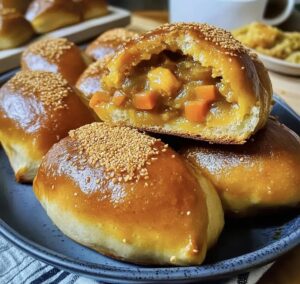
Vegan Japanese Curry Bread Buns Recipe
- Total Time: 1 hour 35 minutes
- Yield: 12 1x
Description
Savory Japanese curry bread buns bring comfort and warmth from street food kitchens across Japan. Crispy golden exterior gives way to spicy, aromatic curry filling that will satisfy hungry souls seeking delicious plant-based adventure.
Ingredients
Main Ingredients:
- 3 cups all-purpose flour
- 1 cup diced potatoes
- 1/2 cup diced carrots
- 1/2 cup diced onions
- 1/2 cup diced bell peppers
- 1 cup vegetable stock
Spices and Seasonings:
- 2 tablespoons curry powder
- 1 tablespoon sugar
- 1 teaspoon salt
- 2 teaspoons instant yeast
- Salt to taste
- 2 tablespoons flour (to thicken)
Liquids and Coating:
- 1 cup warm water
- 2 tablespoons oil
- 1 tablespoon oil
- 1/2 cup plant-based milk
- 1 cup breadcrumbs
Instructions
- Caramelize onions in a skillet over medium heat until they turn translucent and develop a soft, golden hue.
- Incorporate diced carrots, potatoes, and bell peppers into the pan, sautéing for 3-4 minutes until vegetables begin to soften.
- Sprinkle curry powder across the vegetable mixture, stirring thoroughly to distribute the spices evenly. Pour in vegetable stock and allow the mixture to simmer for 8-10 minutes until it reduces and thickens.
- Create a quick slurry by blending flour with water, then fold into the curry to enhance its consistency. Season with salt and let the filling cool completely at room temperature.
- Combine flour, sugar, salt, and instant yeast in a mixing bowl. Gradually introduce warm water and oil, kneading the mixture until it transforms into a smooth, elastic dough with a uniform texture.
- Cover the dough and place in a draft-free environment for approximately 60 minutes, allowing it to double in volume.
- Portion the dough into equal segments, rolling each into a circular shape. Place a generous spoonful of cooled curry filling in the center, carefully sealing the edges to create compact, rounded buns.
- Dunk each bun into plant-based milk, ensuring complete coverage, then roll in breadcrumbs to create a crisp, golden exterior.
- Heat oil in a deep skillet to 350°F for shallow frying. Carefully lower the breaded buns and fry for 2-3 minutes per side until they achieve a rich, golden-brown color. Transfer to paper towels to absorb excess oil.
- Plate the piping hot curry buns immediately, accompanied by your preferred dipping sauce for an enhanced flavor experience.
Notes
- Perfect Oil Temperature Use a thermometer to maintain consistent oil around 350-375°F for crispy, golden exterior without burning.
- Prevent Leaking When sealing buns, press edges firmly and create a tight seal to stop curry from leaking during frying.
- Gluten-Free Adaptation Replace all-purpose flour with a gluten-free blend and use gluten-free breadcrumbs for celiac-friendly version.
- Flavor Boost Add minced garlic or ginger to curry filling for deeper, more complex taste profile.
- Prep Time: 1 hour 20 minutes
- Cook Time: 15 minutes
- Category: Lunch, Snacks
- Method: Frying
- Cuisine: Japanese
Nutrition
- Serving Size: 12
- Calories: 140 kcal
- Sugar: 2 g
- Sodium: 180 mg
- Fat: 3 g
- Saturated Fat: 0.4 g
- Unsaturated Fat: 2.6 g
- Trans Fat: 0 g
- Carbohydrates: 25 g
- Fiber: 2.5 g
- Protein: 3.5 g
- Cholesterol: 0 mg

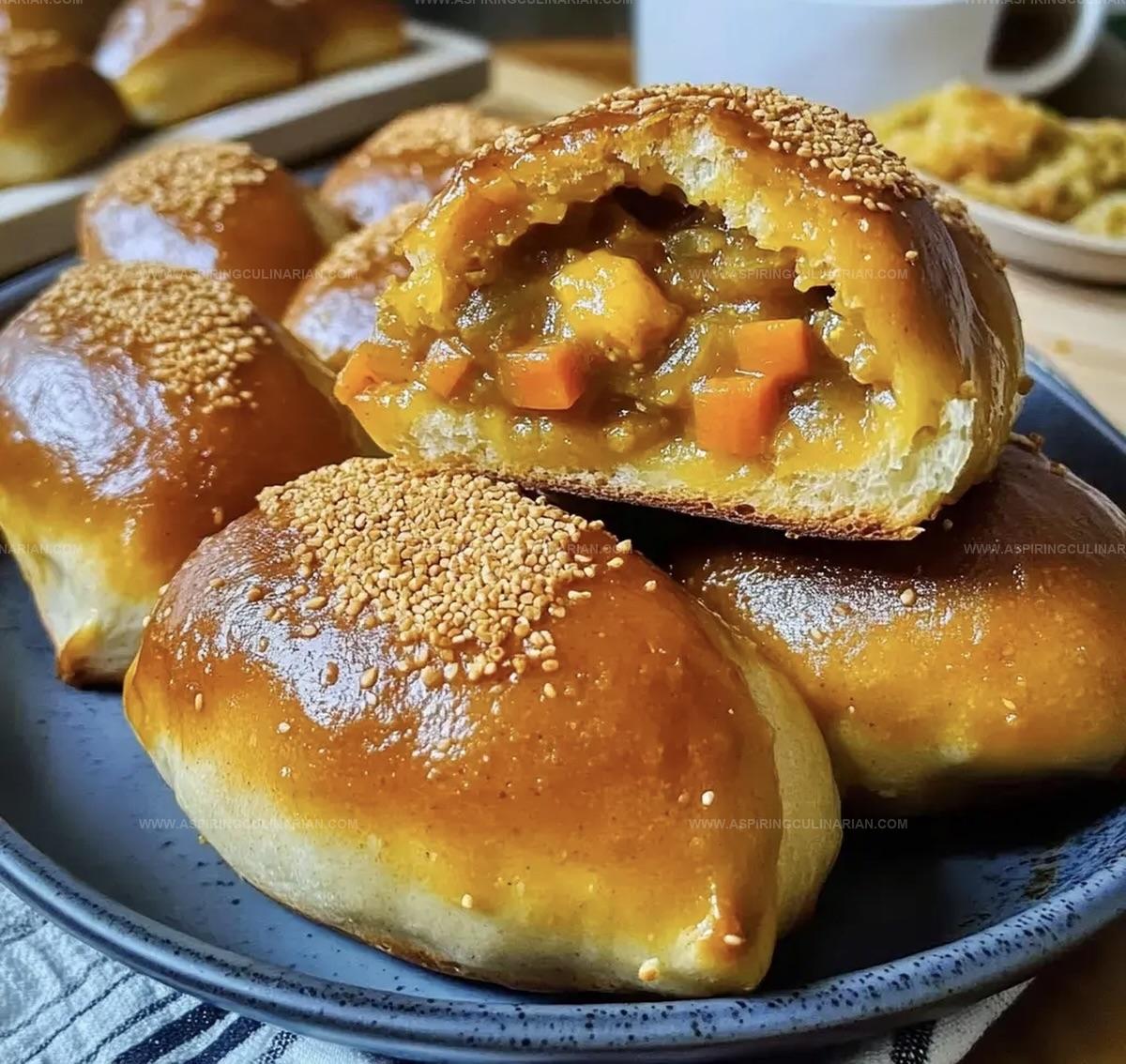
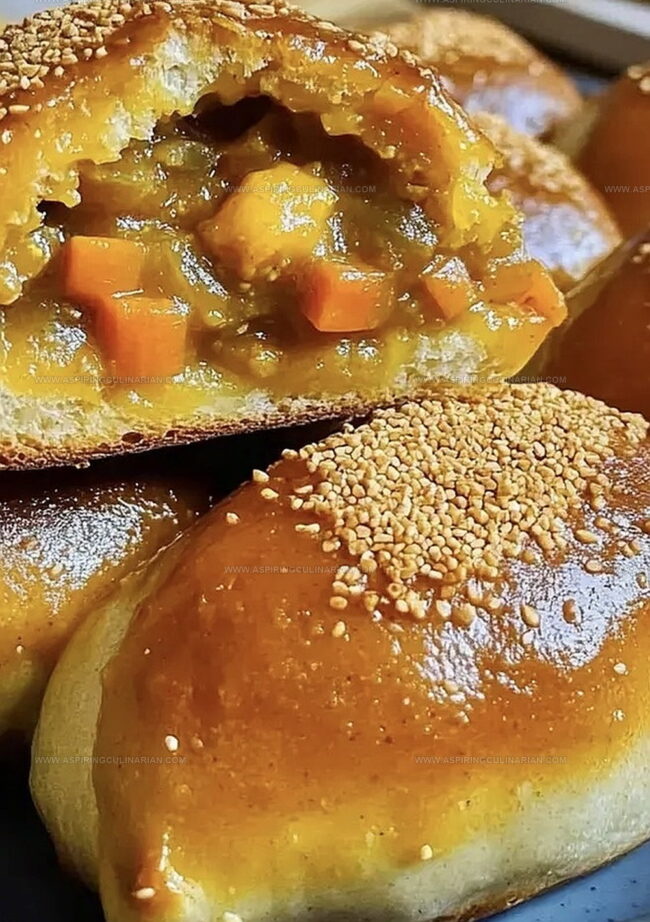
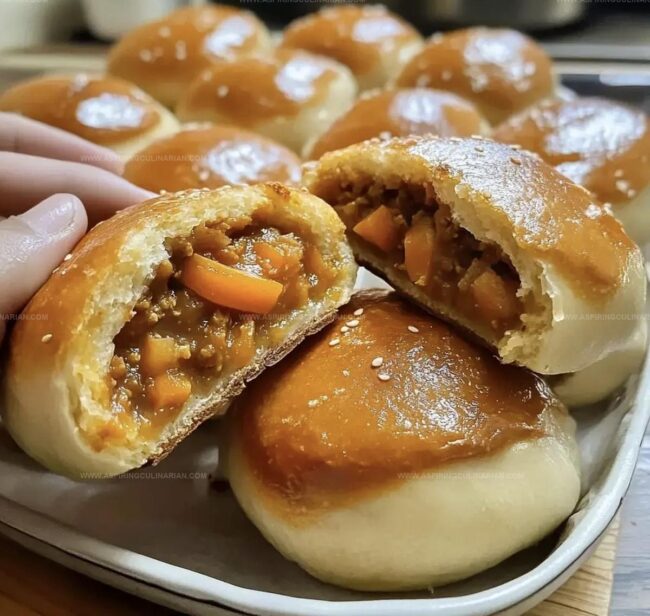
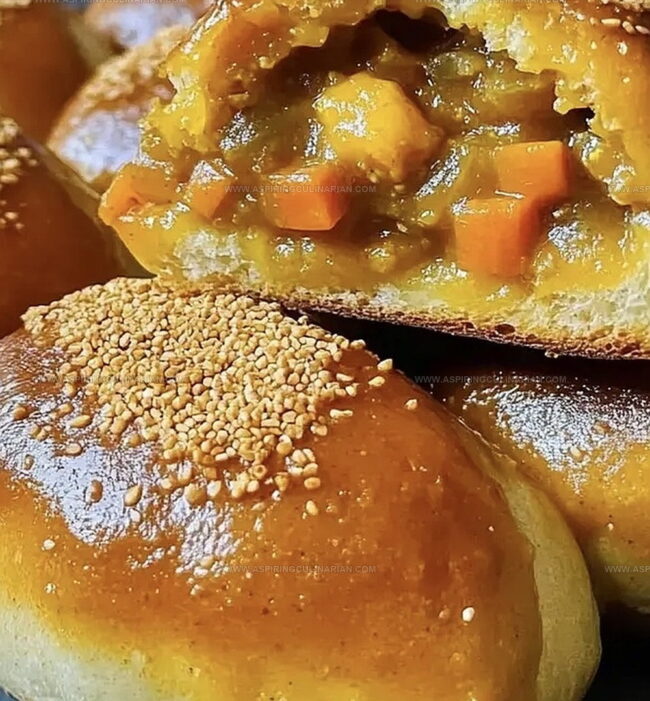
Nathaniel Brooks
Founder & Recipe Developer
Expertise
Farm-to-table cuisine, Seasonal recipe development, Culinary storytelling
Education
Ivy Tech Community College – Indianapolis, IN
Culinary Arts / Hospitality Administration & Events
Focused on hands-on training in classical and modern culinary techniques.
Nathaniel’s story starts in the foothills of the Appalachian Mountains, where farm stands, backyard gardens, and old family recipes shaped his love for real food. After graduating from Ivy Tech Community College in Indianapolis, he spent years working in farm-to-table kitchens, learning how to turn local, seasonal ingredients into something memorable.
Today, Nathaniel pours that same spirit into every single recipe on Aspiring Culinarian – recipes that feel real, comforting, and connected to the land. When he’s not in the kitchen, you’ll find him foraging wild herbs, chasing sunsets with his camera, or writing about the flavors that shaped his roots.